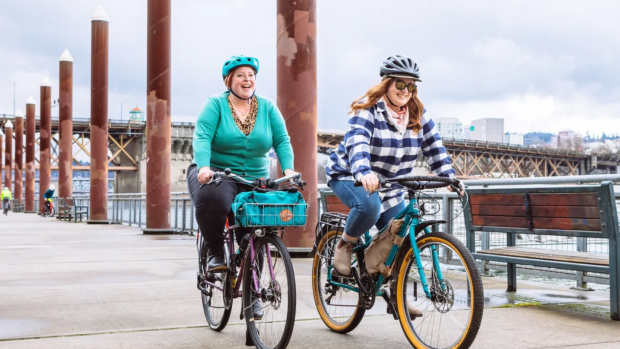
Last month I attended a webinar on ways to create cycling communities that are welcoming to people of all sizes. “Fat Bikers: Creating a Size Inclusive Bike Community” was lead by Marley Blonsky and Kailey Kornhauser. Marley was featured in a Washington Post article about fat bikers. Kailey wrote for Bicycling magazine about her experiences as a fat biker in, “I’m a Fat Cyclist — And I Don’t Need to ‘Fix’ My Body.”
During the pandemic it’s hard to say when we will be able to go on group rides again. But this information can be helpful for ride organizers and bike shop owners looking to create a space that is body-positive.
The webinar began with a few ground rules. These rules can be extended to group rides and cycle shops to create a more welcoming environment:
- Fat is not a bad word. The speakers acknowledged that everyone’s relationship with the word “fat” is different. Some people see fat as a descriptor, just like “tall”,“short”, or “red-headed,” while other people are offended by the word. If you’re unsure of whether or not you’ll offend someone, “plus-sized” or “people/person of size” should be fine. A good rule of thumb is to mirror the other person’s language.
- No diet talk. Comments such as referring to the ride as a way to “work off” a meal fall under diet talk.
- No body shaming. Unfortunately I’ve seen a lot of body shaming within the biking Twitter community I’m a part of. Lots of people poke fun at people of size and comment that if they biked for transportation they wouldn’t be fat, or imply that all fat people are “lazy.” These comments suggest that being fat is some kind of personal failure. A person’s body size or weight has no bearing on their worth as a human being.
- Beware of coded language. Beware of your assumptions and judgements around people with larger bodies. An example of coded language is, “You’re so body positive!” or “It’s so good you’re taking care of yourself.” These things are rarely said to thin people.
- Celebrate your body for what it can do, not what it can’t.
After the speakers discussed the ground rules, they introduced the concept of the “Fatness Spectrum.” Marley and Kailey said they experience privilege as “small fats,” people of size who “can find clothes that fit at mainstream brands and can shop at many stores.” Being familiar with the Fatness Spectrum can be useful for understanding the challenges and discrimination that people of size face.
After the introduction portion, we did some reflection and discussion. We were asked:
- What do you love about your body?
- When do you feel limited by your body?
- How can you be an ally to people of all sizes as a leader in the WTF (Women, Trans, and Femme) bike community?
- How can we create spaces that are welcoming and accessible to all that allow anyone who wants to enjoy the fun/freedom/power experience of riding a bicycle?
Next was a discussion of clothing and gear. Marley mentioned that cyclists in larger bodies may wear out brake pads or pedals at a faster rate. She recommended that olks keep extra components on hand to reduce your trips to the bike shop. Here are some helpful links if you’re interested in knowing how to choose a plus-size-friendly bike and know the weight limits of different bike manufacturers. We learned how bike shops can be more size-inclusive. I found that piece a little hard to follow since I am not familiar with the nuts-and-bolts of bike components but I will link to the webinar once the replay is shared so that those who want to learn more about this subject can check out the discussion.
I was most interested in learning how group rides can be more inclusive. We were shown two advertisements for group rides and went through the positives and negatives of their advertising approach. Here’s what I learned:
- Be upfront about the length and pacing expectations of a ride. Inform participants as to whether or not there will be hill climbing on the ride.
- Be clear on what participants need to bring, including whether or not participants need to bring their own bike and/or if using bike-share bikes is an option.
- Inform participants as to whether the ride will end at the starting place, or whether they will be responsible for biking home home by themselves.
- Providing route descriptions and a map can be super-helpful.
- Inform participants whether or not it’s appropriate for children or teens to come along for the ride.
- Provide an opportunity for people to share their limitations and needs. Preferably this would happen before the ride, so organizers can plan accordingly or, if necessary, inform the rider that they cannot be accommodated.
Lastly, we learned how to be an ally to folks of size. The main message was to speak up. Let bike manufacturers know there is a need for bikes with higher weight limits, inform clothing companies of the need for clothing in larger sizes, aka “inclusive clothing,” and speak up at rides if you see something that could present a challenge for a person of size. An example of the latter is a group ride that was advertised as a 20-mile ride but was ultimately turned into a 40 mile ride. That’s not to say this wouldn’t present a challenge to many people of smaller size as well. It’s about reducing the emotional labor for folks in larger bodies.
If you want to educate yourself to be an ally to fat people, check out these resources:






